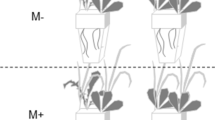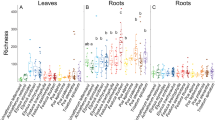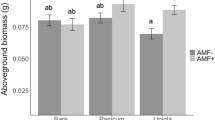Abstract
Soil biota can determine plant invasiveness, yet biogeographical comparisons of microbial community composition and function across ranges are rare. We compared interactions between Conyza canadensis, a global plant invader, and arbuscular mycorrhizal (AM) fungi in 17 plant populations in each native and non-native range spanning similar climate and soil fertility gradients. We then grew seedlings in the greenhouse inoculated with AM fungi from the native range. In the field, Conyza plants were larger, more fecund, and associated with a richer community of more closely related AM fungal taxa in the non-native range. Fungal taxa that were more abundant in the non-native range also correlated positively with plant biomass, whereas taxa that were more abundant in the native range appeared parasitic. These patterns persisted when populations from both ranges were grown together in a greenhouse; non-native populations cultured a richer and more diverse AM fungal community and selected AM fungi that appeared to be more mutualistic. Our results provide experimental support for evolution toward enhanced mutualism in non-native ranges. Such novel relationships and the rapid evolution of mutualisms may contribute to the disproportionate abundance and impact of some non-native plant species.
Similar content being viewed by others
Log in or create a free account to read this content
Gain free access to this article, as well as selected content from this journal and more on nature.com
or
Data availability
Population means required to repeat analyses are available in the Supplementary Information for this paper.
References
Pimentel D, McNair S, Janecka J, Wightman J, Simmonds C, O’Connell C, et al. Economic and environmental threats of alien plant, animal, and microbe invasions. Agric Ecosyst Environ. 2001;84:1–20.
Diagne C, Leroy B, Vaissière AC, Gozlan RE, Roiz D, Jarić I, et al. High and rising economic costs of biological invasions worldwide. Nature. 2021;592:571–6.
Catford JA, Jansson R, Nilsson C. Reducing redundancy in invasion ecology by integrating hypotheses into a single theoretical framework. Divers Distrib. 2009;15:22–40.
Pearson DE, Ortega YK, Eren Ö, Hierro JL. Community assembly theory as a framework for biological invasions. Trends Ecol Evol. 2018;33:313–25.
Inderjit, van der Putten WH. Impacts of soil microbial communities on exotic plant invasions. Trends Ecol Evol. 2010;25:512–9.
Keane RM, Crawley MJ. Exotic plant invasions and the enemy release hypothesis. Trends Ecol Evol. 2002;17:164–70.
Stinson KA, Campbell SA, Powell JR, Wolfe BE, Callaway RM, Thelen GC, et al. Invasive plant suppresses the growth of native tree seedlings by disrupting belowground mutualisms. PLoS Biol. 2006;4:e140.
Hierro JL, Callaway RM. Allelopathy and exotic plant invasion. Plant Soil. 2003;256:29–39.
Reinhart KO, Callaway RM. Soil biota and invasive plants. N Phytol. 2006;170:445–57.
Waller LP, Allen WJ, Barratt BIP, Condron LM, França FM, Hunt JE, et al. Biotic interactions drive ecosystem responses to exotic plant invaders. Science. 2020;368:967–72.
McLeod ML, Cleveland CC, Lekberg Y, Maron JL, Philippot L, Bru D, et al. Exotic invasive plants increase productivity, abundance of ammonia-oxidizing bacteria and nitrogen availability in intermountain grasslands. J Ecol. 2016;104:994–1002.
Saul WC, Jeschke JM. Eco-evolutionary experience in novel species interactions. Ecol Lett. 2015;18:236–45.
Desprez-Loustau M, Robin C, Buee M, Courtecuisse R, Garbaye J, Suffert F, et al. The fungal dimension of biological invasions. Trends Ecol Evol. 2007;22:472–80.
Hierro JL, Maron JL, Callaway RM. A biogeographical approach to plant invasions: the importance of studying exotics in their introduced and native range. J Ecol. 2005;93:5–15.
Callaway RM, Thelen GC, Rodriguez A, Holben WE. Soil biota and exotic plant invasion. Nature. 2004;427:731–3.
Maron JL, Klironomos J, Waller L, Callaway RM. Invasive plants escape from suppressive soil biota at regional scales. J Ecol. 2014;102:19–27.
Brundrett MC. Mycorrhizal associations and other means of nutrition of vascular plants: understanding the global diversity of host plants by resolving conflicting information and developing reliable means of diagnosis. Plant Soil. 2009;320:37–77.
Smith SE, Read DJ. Mycorrhizal symbiosis. London: Academic Press; 2008.
O’Neill EG, O’Neill RV, Norby RJ. Hierarchy theory as a guide to mycorrhizal research on large-scale problems. Environ Pollut. 1991;73:271–84.
Johnson NC, Wilson GWTT, Wilson JA, Miller RM, Bowker MA. Mycorrhizal phenotypes and the Law of the Minimum. N Phytol. 2015;205:1473–84.
Lekberg Y, Arnillas CA, Borer ET, Bullington LS, Fierer N, Kennedy PG, et al. Nitrogen and phosphorus fertilization consistently favor pathogenic over mutualistic fungi in grassland soils. Nat Commun. 2021;12:3484.
Richardson DM, Allsopp N, D’Antonio CM, Milton S, Rejmanek M. Plant invasions - the role of mutualisms. Biol Rev. 2000;75:65–93.
Marler MJ, Zabinski CA, Callaway RM. Mycorrhizae indirectly enhance competitive effects of an invasive forb on a native bunchgrass. Ecology. 1999;80:1180–6.
Soti PG, Jayachandran K, Purcell M, Volin JC, Kitajima K. Mycorrhizal symbiosis and Lygodium microphyllum invasion in South Florida—a biogeographic comparison. Symbiosis. 2014;62:81–90.
Fumanal B, Plenchette C, Chauvel B, Bretagnolle F. Which role can arbuscular mycorrhizal fungi play in the facilitation of Ambrosia artemisiifolia L. invasion in France? Mycorrhiza. 2006;17:25–35.
Hart MM, Reader RJ. Taxonomic basis for variation in the colonization strategy of arbuscular mycorrhizal fungi. N Phytol. 2002;153:335–44.
Maherali H, Klironomos JN. Influence of phylogeny on fungal community assembly and ecosystem functioning. Science. 2007;316:1746–8.
Kivlin SN, Hawkes CV, Treseder KK. Global diversity and distribution of arbuscular mycorrhizal fungi. Soil Biol Biochem. 2011;43:2294–303.
Davison J, Moora M, Öpik M, Adholeya A, Ainsaar L, Bâ A, et al. Global assessment of arbuscular mycorrhizal fungus diversity reveals very low endemism. Science. 2015;349:970–3.
Mitchell CE, Agrawal AA, Bever JD, Gilbert GS, Hufbauer RA, Klironomos JN, et al. Biotic interactions and plant invasions. Ecol Lett. 2006;9:726–40.
Ehrenfeld JG. Effects of exotic plant invasions on soil nutrient cycling processes. Ecosystems. 2003;6:503–23.
Rout ME, Chrzanowski TH. The invasive Sorghum halepense harbors endophytic N2-fixing bacteria and alters soil biogeochemistry. Plant Soil. 2009;315:163–72.
Sardans J, Bartrons M, Margalef O, Gargallo-Garriga A, Janssens IA, Ciais P, et al. Plant invasion is associated with higher plant-soil nutrient concentrations in nutrient-poor environments. Glob Change Biol. 2017;23:1282–91.
Bossdorf O, Auge H, Lafuma L, Rogers WE, Siemann E, Prati D. Phenotypic and genetic differentiation between native and introduced plant populations. Oecologia. 2005;144:1–11.
Lankau RA. Resistance and recovery of soil microbial communities in the face of Alliaria petiolata invasions. N Phytol. 2011;189:536–48.
Blossey B, Nötzold R. Evolution of increased competitive ability in invasive nonindigenous plants: a hypothesis. J Ecol. 1995;83:887–9.
van Kleunen M, Bossdorf O, Dawson W. The ecology and evolution of alien plants. Annu Rev Ecol Evol Syst. 2018;49:25–47.
Rosche C, Hensen I, Schaar A, Zehra U, Jasieniuk M, Callaway RM, et al. Climate outweighs native vs. nonnative range‐effects for genetics and common garden performance of a cosmopolitan weed. Ecol Monogr. 2019;89:e01386.
Weaver SE. The biology of Canadian weeds. 115. Conyza canadensis. Can J Plant Sci. 2001;81:867–75.
Gange AC, Ayres RL. On the relation between arbuscular mycorrhizal colonization and plant ’ benefit. Oikos. 1999;87:615–21.
Řezáčová V, Konvalinková T, Řezáč M. Decreased mycorrhizal colonization of Conyza canadensis (L.) Cronquist in invaded range does not affect fungal abundance in native plants. Biologia. 2020;75:693–9.
Zhang Q, Sun Q, Koide RT, Peng Z, Zhou J, Gu X, et al. Arbuscular mycorrhizal fungal mediation of plant-plant onteractions in a marshland plant community. Sci World J. 2014;2014:1–10.
Zhang HY, Goncalves P, Copeland E, Qi SS, Dai ZC, Li GL, et al. Invasion by the weed Conyza canadensis alters soil nutrient supply and shifts microbiota structure. Soil Biol Biochem. 2020;143:107739.
Shah MA, Callaway RM, Shah T, Houseman GR, Pal RW, Xiao S, et al. Conyza canadensis suppresses plant diversity in its nonnative ranges but not at home: a transcontinental comparison. N Phytol. 2014;202:1286–96.
Colautti RI, Lau JA. Contemporary evolution during invasion: evidence for differentiation, natural selection, and local adaptation. Mol Ecol. 2015;24:1999–2017.
Rosche C, Hensen I, Lachmuth S. Local pre-adaptation to disturbance and inbreeding-environment interactions affect colonisation abilities of diploid and tetraploid Centaurea stoebe. Plant Biol. 2018;20:75–84.
Hart SC, Start JM, Davidson EA, Firestone MK. Nitrogen mineralization, immobilization, and nitrification. In: Weaver RW, Angle J., Bottomley P., editors. Methods of soil analysis, part 2 microbiological and biochemical properties. Madison, WI: Soil Science Society of America; 1994. p. 985–1018.
Brundrett M, Bougher N, Dell B, Grove T, Malajczuk N. Working with mycorrhizas in forestry and agriculture. ACIAR Monogr. 1996;32:1–374.
McGonigle TP, Miller MH, Evans DG, Fairchild GL, Swan JA. A new method which gives an objective measure of colonization of roots by vesicular—arbuscular mycorrhizal fungi. N Phytol. 1990;115:495–501.
Fick SE, Hijmans RJ. WorldClim 2: new 1-km spatial resolution climate surfaces for global land areas. Int J Climatol. 2017;4315:4302–15.
Hijmans RJ. raster: Geographic data analysis and modeling. R package version 3.3-13. 2020. https://cran.r-project.org/package=raster.
R Core Team. R: A language and environment for statistical computing [https://www.r-project.org/]. Vienna, Austria: R Foundation for Statistical Computing; 2019.
Oksanen J, Guillaume BF, Friendly M, Kindt R, Legendre P, McGlinn D, et al. vegan: community ecology package. R package. 2019. https://cran.r-project.org/package=vegan.
Dumbrell AJ, Ashton PD, Aziz N, Feng G, Nelson M, Dytham C, et al. Distinct seasonal assemblages of arbuscular mycorrhizal fungi revealed by massively parallel pyrosequencing. N Phytol. 2011;190:794–804.
Lee J, Lee S, Young JPW. Improved PCR primers for the detection and identification of arbuscular mycorrhizal fungi. FEMS Microbiol Ecol. 2008;65:339–49.
Bullington LS, Lekberg Y, Larkin BG. Insufficient sampling constrains our characterization of plant microbiomes. Sci Rep. 2021;11:3645.
Bolyen E, Rideout JR, Dillon MR, Bokulich NA, Abnet CC, Al-Ghalith GA, et al. Reproducible, interactive, scalable and extensible microbiome data science using QIIME 2. Nat Biotechnol. 2019;37:852–7.
Callahan BJ, McMurdie PJ, Rosen MJ, Han AW, Johnson AJA, Holmes SP. DADA2: high-resolution sample inference from Illumina amplicon data. Nat Methods. 2016;13:581–3.
Öpik M, Vanatoa A, Vanatoa E, Moora M, Davison J, Kalwij JM, et al. The online database MaarjAM reveals global and ecosystemic distribution patterns in arbuscular mycorrhizal fungi (Glomeromycota). N Phytol. 2010;188:223–41.
Chen J. GUniFrac: generalized UniFrac distances. R package version 1.1. 2018. https://cran.r-project.org/package=GUniFrac.
Webb CO. Exploring the phylogenetic structure of ecological communities: an example for rain forest trees. Am Nat. 2000;156:145–55.
Kembel SW, Cowan PD, Helmus MR, Cornwell WK, Morlon H, Ackerly DD, et al. Picante: R tools for integrating phylogenies and ecology. Bioinformatics. 2010;26:1463–4.
Katoh K, Standley DM. MAFFT multiple sequence alignment software version 7: improvements in performance and usability. Mol Biol Evol. 2013;30:772–80.
Price MN, Dehal PS, Arkin AP. FastTree 2 – approximately maximum-likelihood trees for large alignments. PLoS ONE. 2010;5:e9490.
Yu G, Smith DK, Zhu H, Guan Y, Lam TT. GGTREE: an R package for visualization and annotation of phylogenetic trees with their covariates and other associated data. Methods Ecol Evol. 2017;8:28–36.
Bates D, Mächler M, Bolker B, Walker S. Fitting linear mixed-effects models using lme4. J Stat Softw. 2014;67.
Borcard D, Gillet F, Legendre P. Numerical ecology with R. New York: Springer; 2011.
Benjamini Y, Hochberg Y. Controlling the false discovery rate: a practical and powerful approach to multiple testing. J R Stat Soc. 1995;57:289–300.
Anderson MJ, Walsh DCI. PERMANOVA, ANOSIM, and the Mantel test in the face of heterogeneous dispersions: What null hypothesis are you testing? Ecol Monogr. 2013;83:557–74.
Love MI, Huber W, Anders S. Moderated estimation of fold change and dispersion for RNA-seq data with DESeq2. Genome Biol. 2014;15:550.
Felker-Quinn E, Schweitzer JA, Bailey JK. Meta-analysis reveals evolution in invasive plant species but little support for Evolution of Increased Competitive Ability (EICA). Ecol Evol. 2013;3:739–51.
Pal RW, Maron JL, Nagy DU, Waller LP, Tosto A, Liao H, et al. What happens in Europe stays in Europe: apparent evolution by an invader does not help at home. Ecology 2020;101:e03072.
Matesanz S, Sultan SE. High-performance genotypes in an introduced plant: insights to future invasiveness. Ecology. 2013;94:2464–74.
Hart M, Reader R. Host plant benefit from association with arbuscular mycorrhizal fungi: variation due to differences in size of mycelium. Biol Fertil Soils. 2002;36:357–66.
Yang H, Zhang Q, Koide RT, Hoeksema JD, Tang J, Bian X, et al. Taxonomic resolution is a determinant of biodiversity effects in arbuscular mycorrhizal fungal communities. J Ecol. 2017;105:219–28.
Moora M, Berger S, Davison J, Öpik M, Bommarco R, Bruelheide H, et al. Alien plants associate with widespread generalist arbuscular mycorrhizal fungal taxa: evidence from a continental-scale study using massively parallel 454 sequencing. J Biogeogr. 2011;38:1305–17.
Policelli N, Bruns TD, Vilgalys R, Nuñez MA. Suilloid fungi as global drivers of pine invasions. N Phytol. 2019;222:714–25.
Jia Y, Heijden MGA, Wagg C, Feng G, Walder F. Symbiotic soil fungi enhance resistance and resilience of an experimental grassland to drought and nitrogen deposition. J Ecol. 2021;109:3171–81.
Van Der Heijden MGAA, Klironomos JN, Ursic M, Moutoglis P, Streitwolf-Engel R, Boller T, et al. Mycorrhizal fungal diversity determines plant biodiversity, ecosystem variability and productivity. Nature. 1998;396:69–72.
Zhang Q, Yang R, Tang J, Yang H, Hu S, Chen X. Positive feedback between mycorrhizal fungi and plants influences plant invasion success and resistance to invasion. PLoS ONE. 2010;5:e12380.
Shah MA, Reshi ZA, Khasa DP. Arbuscular mycorrhizas: drivers or passengers of alien plant invasion. Bot Rev. 2009;75:397–417.
Valverde-Barrantes OJ, Horning AL, Smemo KA, Blackwood CB. Phylogenetically structured traits in root systems influence arbuscular mycorrhizal colonization in woody angiosperms. Plant Soil. 2016;404:1–12.
Wilson GWT, Hartnett DC. Interspecific variation in plant responses to mycorrhizal colonization in tallgrass prairie. Am J Bot. 1998;85:1732–8.
Seifert EK, Bever JD, Maron JL. Evidence for the evolution of reduced mycorrhizal dependence during plant invasion. Ecology 2009;90:1055–62.
Deveautour C, Donn S, Power SA, Bennett AE, Powell JR. Experimentally altered rainfall regimes and host root traits affect grassland arbuscular mycorrhizal fungal communities. Mol Ecol. 2018;27:2152–63.
Osborne OG, De-Kayne R, Bidartondo MI, Hutton I, Baker WJ, Turnbull CGN, et al. Arbuscular mycorrhizal fungi promote coexistence and niche divergence of sympatric palm species on a remote oceanic island. N Phytol. 2018;217:1254–66.
Tian B, Pei Y, Huang W, Ding J, Siemann E. Increasing flavonoid concentrations in root exudates enhance associations between arbuscular mycorrhizal fungi and an invasive plant. ISME J. 2021;15:1919–30.
Pimprikar P, Gutjahr C. Transcriptional regulation of arbuscular mycorrhiza development. Plant Cell Physiol. 2018;59:673–90.
Wendlandt CE, Helliwell E, Roberts M, Nguyen KT, Friesen ML, Wettberg E, et al. Decreased coevolutionary potential and increased symbiont fecundity during the biological invasion of a legume‐rhizobium mutualism. Evolution. 2021;75:731–47.
Callaway RM, Bedmar EJ, Reinhart KO, Silvan CG, Klironomos J. Effects of soil biota from different ranges on Robinia invasion: acquiring mutualists and escaping pathogens. Ecology. 2011;92:1027–35.
Shelby N, Duncan RP, Putten WH, McGinn KJ, Weser C, Hulme PE. Plant mutualisms with rhizosphere microbiota in introduced versus native ranges. J Ecol. 2016;104:1259–70.
Yang Q, Carrillo J, Jin H, Shang L, Hovick SM, Nijjer S, et al. Plant–soil biota interactions of an invasive species in its native and introduced ranges: Implications for invasion success. Soil Biol Biochem. 2013;65:78–85.
Bronstein JL. The exploitation of mutualisms. Ecol Lett. 2001;4:277–87.
Kiers ET, Duhamel M, Beesetty Y, Mensah JA, Franken O, Verbruggen E, et al. Reciprocal rewards stabilize cooperation in the mycorrhizal symbiosis. Science. 2011;333:880–2.
Koziol L, Bever JD. Mycorrhizal feedbacks generate positive frequency dependence accelerating grassland succession. J Ecol. 2019;107:622–32.
Yang H, Yuan Y, Zhang Q, Tang J, Liu Y, Chen X. Changes in soil organic carbon, total nitrogen, and abundance of arbuscular mycorrhizal fungi along a large-scale aridity gradient. Catena. 2011;87:70–7.
Zhang J, Wang F, Che R, Wang P, Liu H, Ji B, et al. Precipitation shapes communities of arbuscular mycorrhizal fungi in Tibetan alpine steppe. Sci Rep. 2016;6:23488.
Read DJ. Mycorrhizas in ecosystems. Experientia. 1991;47:376–91.
Delavaux CS, Smith-Ramesh LM, Kuebbing SE. Beyond nutrients: a meta-analysis of the diverse effects of arbuscular mycorrhizal fungi on plants and soils. Ecology. 2017;98:2111–9.
Acknowledgements
YL, MM, and LSB are thankful to MPG Ranch for funding. MS is thankful to Shaanxi provincial special program for technological innovation (2020QFY10-01), Shaanxi Provincial Natural Science Foundation (2021JM-094) and China Scholarship Council for funding. CR was supported by a DAAD postdoctoral fellowship (91554701). RMC thanks the National Science Foundation EPSCoR Track-1 Cooperative Agreement (OIA-1757351) for support. MAS acknowledges the support from the RUSA 2.0 Project by MHRD Govt. of India and DK acknowledges the support of a Discovery Grant (from NSERC). The authors thank Kelly LaFlamme for help with greenhouse maintenance, harvest, and sample processing, and Martine Lapointe and Marie-Eve Beaulieu (Université Laval) for collecting plant material and field data in Canada.
Author information
Authors and Affiliations
Contributions
MS, CR, and YL conceived the idea of the study and all co-authors provided input on the design. MS and CR conducted all statistical analyses with input from YL and LB. YL, MS, and CR wrote the first draft. All co-authors were involved in either sampling or sample processing and provided edits to earlier drafts.
Corresponding author
Ethics declarations
Competing interests
The authors declare no competing interests.
Additional information
Publisher’s note Springer Nature remains neutral with regard to jurisdictional claims in published maps and institutional affiliations.
Supplementary information
Rights and permissions
About this article
Cite this article
Sheng, M., Rosche, C., Al-Gharaibeh, M. et al. Acquisition and evolution of enhanced mutualism—an underappreciated mechanism for invasive success?. ISME J 16, 2467–2478 (2022). https://doi.org/10.1038/s41396-022-01293-w
Received:
Revised:
Accepted:
Published:
Issue date:
DOI: https://doi.org/10.1038/s41396-022-01293-w
This article is cited by
-
Arbuscular mycorrhizal fungi travel the world with harvested underground crops
Mycorrhiza (2025)
-
Promotion of Robinia pseudoacacia dominance by arbuscular mycorrhizal fungi from mixed stands with Platycladus orientalis depends on belowground factors
Plant and Soil (2025)
-
Interplay of biotic and abiotic factors shapes tree seedling growth and root-associated microbial communities
Communications Biology (2024)
-
Synergistic changes in AM fungi and soil abiotic properties in rhizosphere soils of invasive Solidago canadensis may confer its stronger dominance in communities
Plant and Soil (2024)
-
Plant G × Microbial E: Plant Genotype Interaction with Soil Bacterial Community Shapes Rhizosphere Composition During Invasion
Microbial Ecology (2024)



